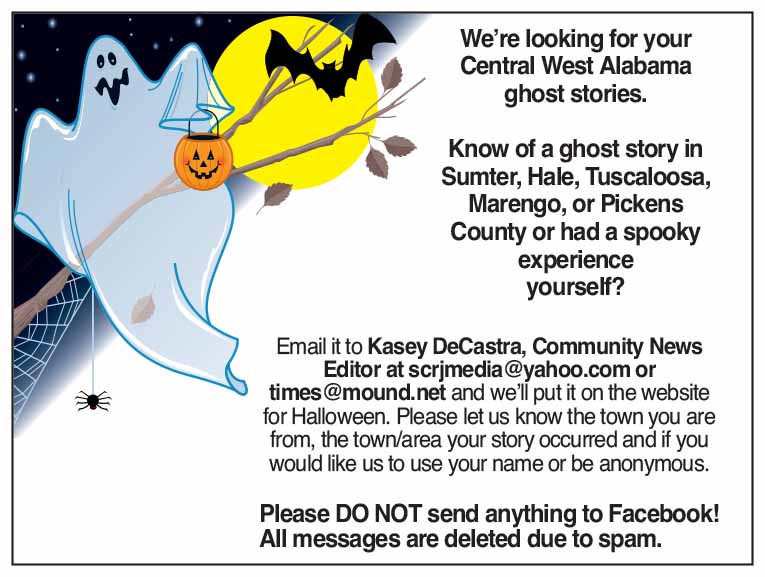
RPT Pumpkin Painting Party
We’ll bring the pumpkins, you bring the creativity on Oct. 21 at 9:30-11 a.m. at Ruby Pickens Tartt Public Library in Livingston. All ages welcome!

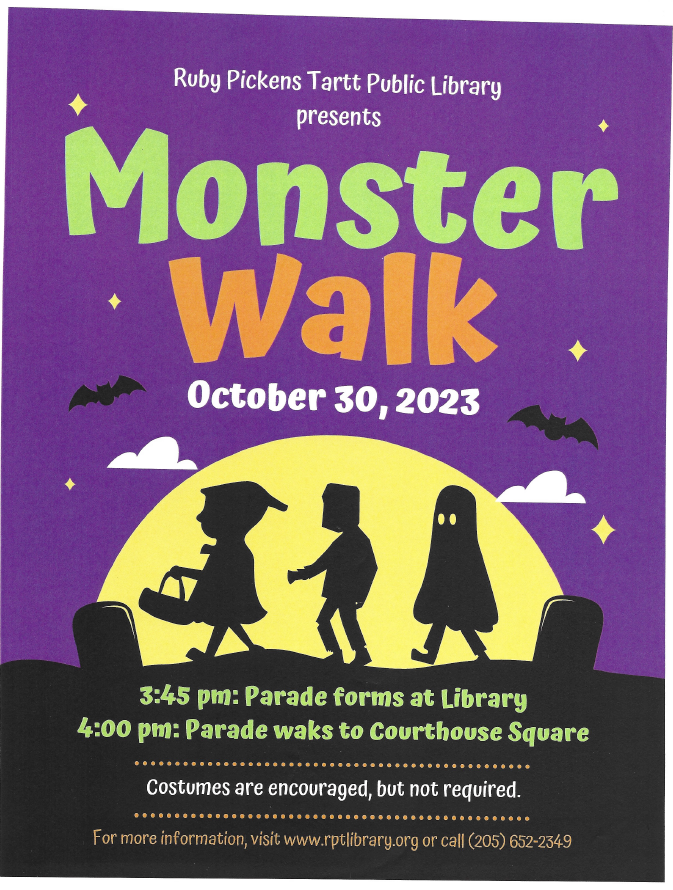
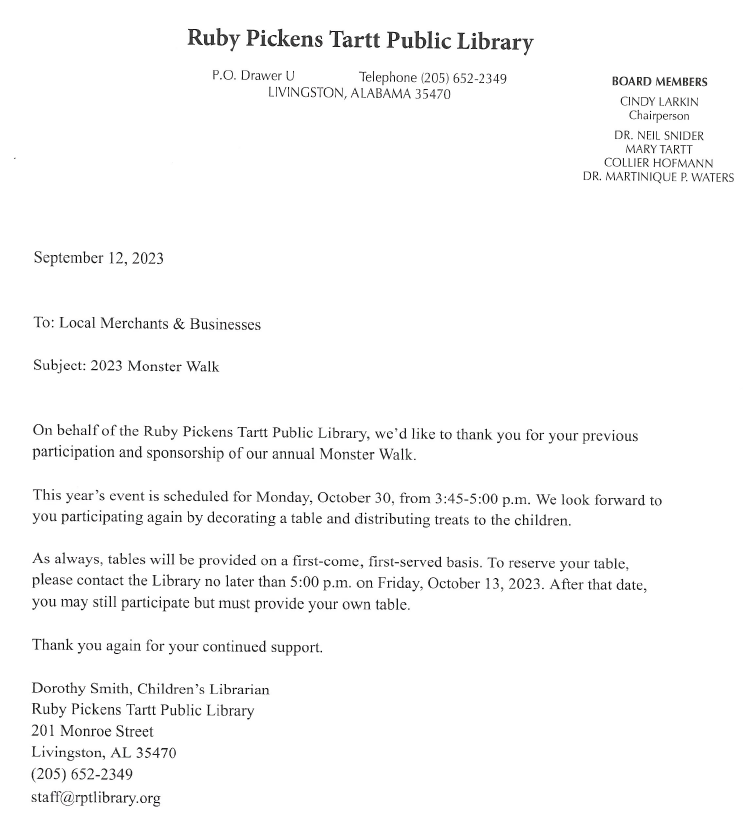
Free Coloring Pages
Click on the coloring page to download a printable pdf.


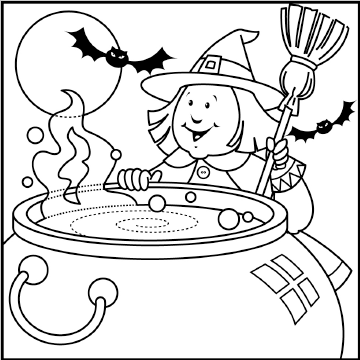
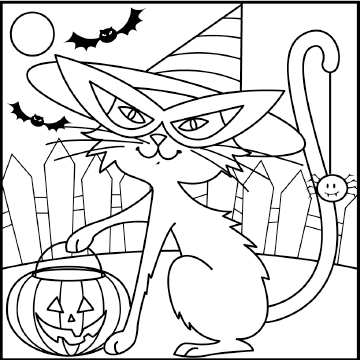
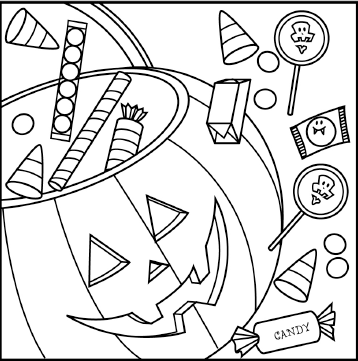
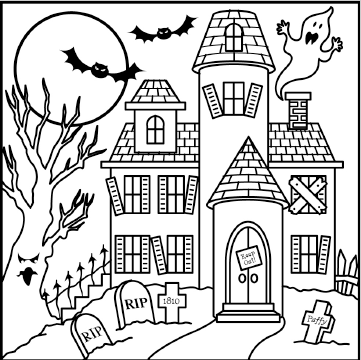
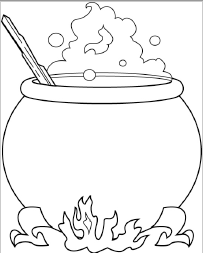
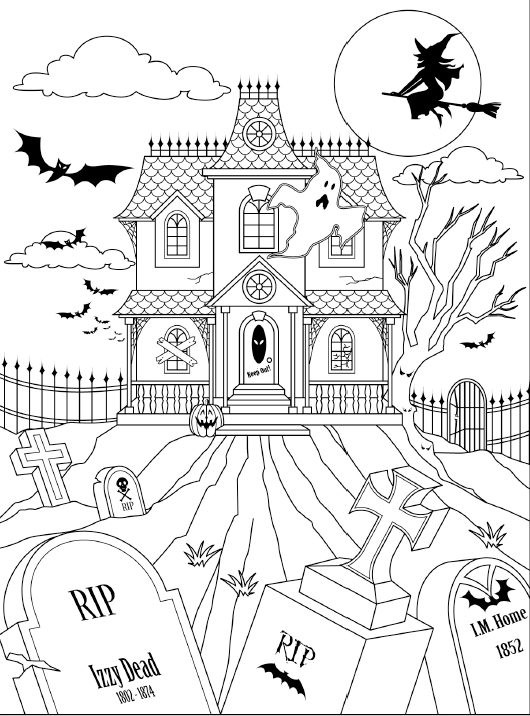
Halloween ‘Cash for Candy’ Program Pays You for Treats While Supporting American Troops
A sweet swap: HealthyWage kicks off ‘Cash for Candy’ program allowing any individual in the U.S. to donate their excess, unwanted and unopened candy, get directly paid for it and, in doing so, support American troops overseas. According to some 2022 reports, obesity remains an ominous health threat across America as the avoidable condition plagues more than a third (36.2%) of the U.S. population. This scary statistic is that much more frightful as the Halloween holiday looms large. However, this year there’s no need to fret as one weight-wise wellness company will pay you cold, hard cash for your candy! This amid the kick-off of HealthyWage’s “Cash for Candy” program, which will pay individuals $10 per pound of candy up to $100 per person—and up to $10,000 in collective payouts! Through the initiative, any individual can donate their excess, unwanted and unopened candy to Operation Shoebox on or before Nov. 22, get directly paid for it and, in doing so, support American troops overseas! Participants need not be a HealthyWage challenge participant as anyone, anywhere in the U.S. can donate candy and cash in. Full submission details and instructions can be found online at https://www.healthywage.com/pages/cash-for-candy-2022.
BATS: DANGEROUS, BLIND BLOOD-SUCKERS OR HELPFUL, BIOLOGICAL PEST CONTROL? – As Halloween approaches, so do stories of vampire bats. But most bats aren’t looking for human blood, according to Dr. John Abbott, chief curator and director of the Department of Museum Research and Collections at The University of Alabama. Bats are found all over the world, but only two types that range in the tropics are blood-feeders. Abbott said this rumor has unfortunately caused bats to gain a bad reputation when they’re really one of the most helpful mammals in existence.
Keep health and safety foremost for Halloween festivities
Protecting families, friends and communities from contracting and spreading the novel coronavirus COVID-19 is a major concern for Alabama families in 2020. Consistent with Centers for Disease Control and Prevention recommendations, the Alabama Department of Public Health (ADPH) encourages families to find safer, alternative activities to traditional door-to-door trick-or-treating this Halloween.
Persons who have COVID-19 or who have been exposed to someone with the virus should not participate in in-person Halloween activities. Anyone exposed to COVID-19 within the past 14 days or who is showing symptoms should remain at home. Of course, people at increased risk of severe illness form COVID-19 should also stay home.
Children can enjoy limited trick-or-treating provided parents assess the risks of each activity, take precautions and carefully supervise. Adults need to emphasize the importance of consistent hand hygiene, proper mask wearing and social distancing where people can remain 6 feet apart or more. Avoiding large, crowded groups is important.
Weigh the risks and consider alternative ways to celebrate. The main indicator for limiting the risk of COVID-19 spread in the community is the number of days a county has a downward trend of new cases. Your county’s current risk level can be found on the ADPH COVID-19 Risk Indicator Dashboard. Halloween activities are grouped according to the following risk levels:
Higher Risk
· Traditional door-to-door trick-or-treating with shared candy bowls
· Trunk-or-treating events
· Crowded indoor events such as haunted houses and costume contests
Moderate Risk
· No-touch trick-or-treating (such as candy chutes)
· Goodie bags placed outside for pickup
· Outdoor, distanced costume parade
· Outdoor, distanced movie night
Lower Risk
· Pumpkin carving at home with family
· Outdoor, distanced pumpkin carving with friends
· Decorating at home
· Outdoor scavenger hunt in neighborhood
· Virtual costume contest
· Movie night with family
Traditional injury prevention and health precautions for Halloween trick-or-treating hold true in 2020. As always, responsible adult supervision is key with trick-or-treating. Safety measures to take beforehand, during and after trick-or-treating include the following:
· Be sure costumes, wigs and accessories are flame-resistant.
· Wear protective face coverings made up of two or more layers of breathable fabric instead of a costume mask. Face coverings can be decorated with themes, too.
· Add reflective tape to costumes.
· Do not wear decorative contact lenses; they can cause eye injuries.
· Be careful to prevent accidental cuts when carving pumpkins.
· Make sure walking areas and stairs are well-lit and free of obstacles.
· Never walk near lit candles or luminaries and avoid distraction from electronic devices.
· Keep candle-lit jack-o’-lanterns away from doorsteps, walkways, landings and curtains.
· Prepare grab-and-go goodie bags for no touch pickup outside.
· Consider providing non-food treats such as crayons and coloring books.
· Examine treats for choking hazards before allowing them to be consumed; limit the amount of sugary and sticky candies consumed.
Preserving Your Jack o’Lantern This Halloween
AUBURN UNIVERSITY, Ala. – Jack-o-lanterns are a Halloween staple, but sadly they seem to fade away in a short amount of time. As Halloween draws closer, people are beginning to select the perfect pumpkin for carving. Before heading to the pumpkin patch, below are a few tricks to keep in mind this Halloween to keep your jack o’ lantern looking fresh.
Picking the Right Pumpkin
Dani Carroll, an Alabama Extension home grounds, gardens and home pests regional agent, said the first way to preserve a jack o’lantern is to initially pick the correct pumpkin.
“Pick a pumpkin without any bacteria or mold that may be growing around the handle and has no soft spots,” Carroll said. “A pumpkin with a nice sized handle is often a better pick than one without.”
Tips at Home
According to Carroll, direct sunlight often breaks pumpkins down faster. Be aware of this when selecting where your jack o’lantern will sit during the day. There are also a few remedies that people can try at home to help preserve their jack o’lantern.
Bleach and Water Solution. This remedy to pumpkin decay might be time-consuming, but it also might solve the problem. Before carving the pumpkin, wash it well to rid the pumpkin of any leftover soil, then dry off with a towel. Once the pumpkin is carved, it will lose moisture. Spray with a weak bleach solution daily (10 percent) along the cuts to enhance moisture.
Use A Commercial Product. Buying a commercial product for pumpkin preservation is another remedy the could prolong its life span. The main components of these commercial preserving solutions are borax, preservative fungicide, sodium and water. Follow the directions on the bottle when spraying on pumpkins. Jack-o-lanterns have been known to last up to 14 days with minimal mold growth. There is only some decay after application of commercial products.
More Information
For more information regarding pumpkin preservation this Halloween, visit the Alabama Extension website or contact your county’s Extension office.
We’re looking for your Central West Alabama ghost stories
*Disclaimer above is not a real ghost. But she is cute as a button.*
We’re looking for your Central West Alabama ghost stories. Know of a ghost story in Sumter, Hale, Tuscaloosa, Marengo, or Pickens County, or had a spooky experience yourself? Email us at [email protected] or [email protected] and we’ll put it on www.recordjournal.net and www.moundvilletimes.net for Halloween. Please let us know the town you are from, the town or area your story occurred and if you would like to use your name or be anonymous. PLEASE DO NOT SEND ANYTHING TO FACEBOOK!
Halloween Safety: Costumes, Candy, and Colored Contact Lenses
Whether you’re a ghost or zombie, vampire or witch, poor costume choices—including decorative (colored) contact lenses and flammable costumes—and face paint allergies can cause injuries that haunt you long after Halloween.
Enjoy a safe and happy Halloween by following these guidelines from FDA, the Consumer Product Safety Commission, and the Centers for Disease Control and Prevention:
• Wear costumes that say “flame resistant” on the label. If you make your costume, use flame-resistant fabrics such as polyester or nylon.
• Wear bright, reflective costumes or add strips of reflective tape so you’ll be more visible; make sure the costumes aren’t so long that you’re in danger of tripping.
• Wear makeup and hats rather than masks that can obscure your vision.
• Test the makeup you plan to use in advance. Put a small amount on the arm of the person who will be wearing it. If a rash, redness, swelling, or other signs of irritation develop where the makeup was applied, that’s a sign of a possible allergy.
• Vibrantly colored makeup is popular at Halloween. Check FDA’s list of color additives to see if the colors are FDA approved. If they aren’t approved for their intended use, don’t use them. This is especially important for colored makeup around the eyes.
• Don’t wear decorative contact lenses unless you have seen an eye care professional for a proper fitting and been given instructions for how to use the lenses.
Safe Treats
Eating sweet treats is also a big part of Halloween fun.
Before you or your children go trick-or-treating, remember these tips:
• Don’t eat candy until it has been inspected at home.
• Eat a snack before heading out to avoid the temptation of nibbling on a treat before it has been inspected.
• In case of a food allergy, check the label to ensure the allergen isn’t present. Tell children not to accept—or eat—anything that isn’t commercially wrapped.
• Parents of very young children should remove any choking hazards such as gum, peanuts, hard candies, or small toys from the Halloween bags.
• Inspect commercially wrapped treats for signs of tampering, such as an unusual appearance or discoloration, tiny pinholes, or tears in wrappers. Throw away anything that looks suspicious.
For partygoers and party throwers, FDA recommends the following tips for two seasonal favorites:
• Unpasteurized juices and juices that have not been further processed are at higher risk of food- borne illness. Look for the warning label to identify juice that hasn’t been pasteurized or otherwise processed, especially packaged juice products made on site. If unsure, always ask if juice has been pasteurized or not. Normally, juice in boxes, bottles or cans from your grocer’s frozen food case, refrigerated section, or shelf has been pasteurized.
• Before bobbing for apples—a favorite Halloween game—reduce the risk of bacteria by thoroughly rinsing the apples under cool running water. As an added precaution, use a produce brush to remove surface dirt.
Eye Safety
FDA joins eye care professionals—including the American Academy of Ophthalmology, the American Association for Pediatric Ophthalmology and Strabismus, the Contact Lens Association of Ophthalmologists and the American Optometric Association—in discouraging consumers from using illegal decorative (colored) contact lenses. These are contact lenses that have not been approved by FDA for safety and effectiveness. Consumers should only use brand name contact lenses from well-known contact lens companies.
If you have never worn contact lenses before, Halloween should not be the first time you wear them. Experts warn that buying any kind of contact lenses—which are medical devices and regulated as such—without an examination and a prescription from an eye care professional can cause serious eye disorders and infections, which may lead to permanent vision loss. Despite the fact that it’s illegal to sell decorative contact lenses without a valid prescription, FDA says the lenses are sold on the Internet and in retail shops and salons—particularly around Halloween.
The decorative lenses make the wearer’s eyes appear to glow in the dark, create the illusion of vertical “cat eyes,” or change the wearer’s eye color.
Although unauthorized use of decorative contact lenses is a concern year-round, Halloween is the time when people may be inclined to use them, perhaps as costume accessories. When they are bought and used without a valid prescription, without the involvement of a qualified eye care professional, or without appropriate follow-up care, it can lead to significant risks of eye injuries, including blindness.
This article appears on the FDA’s Consumer Updates page, which features the latest on all FDA-regulated products.
Prevent tooth decay this Halloween
October is here and that means children everywhere will be getting ready to gorge onand stockpile candy from Halloween. This also means that parents and dentists everywhere will be looking for ways to regulate candy consumption.
The Alabama Department of Public Health (ADPH) Oral Health Branch, through creative collaboration and partnership, is dedicated to making sure resources are available to help educate parents and children on ways to prevent dental decay. For that reason, here are a few tips from the American Dental Association to make sure this year’s Halloween candy haul is cavity free.
Timing
Timing is everything with most things in life, and choosing when to eat Halloween candy is no different. Saliva production increases during meals, which helps to cancel out acids produced by bacteria in the mouth. Choosing to eat sugary snacks with meals or shortly after mealtime can help reduce the effects of tooth decay due to this increase in saliva.
Drink More Water
Multiple sources such as the World Health Organization, Centers for Disease Control and Prevention, and the American Dental Association support proven studies that drinking fluoridated water can help prevent tooth decay. In most cases, tap water is preferred to bottled water because it guarantees the consumption of fluoride as an oral health measure.
Avoid Sticky Candies
Avoid candies that stick to teeth, like taffy and gummy bears. Sticky candies take longer to get washed away by saliva which means there is a greater risk for tooth decay.
Brush Twice a Day
The buildup of plaque that causes gum disease takes just 24 hours to develop. Brushing and flossing teeth in the morning and at night before bed will help prevent the onset of tooth decay. Remember to replace your toothbrush every three or four months.
Cash for Candy
Did you know there are programs that will give you cash for your candy? One such organization is called Halloween Candy Buy Back, and will actually pay $1 per every pound of candy that a child collects! The donated candy is then shipped to troops serving the U.S. overseas. For more information about this program, and to find a participating dental office near you, visit: http://www.halloweencandybuyback.com
For more information on how to prevent tooth decay this holiday season, visit:
http://www.mouthhealthy.org/en/az-topics/h/halloween-tips
http://alabamapublichealth.gov/oralhealth/
The Teal Pumpkin Project
Every child should be able to experience the joy and tradition of trick-or-treating on Halloween. But kids with food allergies are often left out of the fun, since most candy is off limits.
Food allergies are a life-altering and potentially life-threatening disease, and a growing public health issue. In the U.S., one in 13 children has a food allergy – that’s roughly two in every classroom. For these children, even a tiny amount of their allergen has the potential to cause a severe reaction.
Virtually any food can cause a reaction. Many popular Halloween candies contain nuts, milk, egg, soy or wheat, which are some of the most common allergens in children and adults. Additionally, many miniature or fun-size versions of candy items contain different ingredients than their full-size counterparts and some miniature candy items may not have labels, so it is difficult for parents to determine whether these items are safe for their child with food allergies.
Non-food treats provide a safe, fun alternative for children with food allergies and other conditions for whom candy may present a problem.
FARE’s Teal Pumpkin Project helps make sure all children will come home on Halloween night with something they can enjoy. It just takes one simple act: offering non-food treats, such as glow sticks or small toys, as an alternative to candy.
Last year, households from all 50 states and 14 countries participated. This is a worldwide movement to create a safer, happier Halloween for all trick-or-treaters.
The goal is not to exclude candy from the Halloween tradition. The goal is simply to ensure that children with food allergies – and other children for whom candy is not an option – are able to enjoy a safer, happier Halloween. Trick-or-treaters typically receive pounds of candies and chocolates, and we’re sure they will continue to collect plenty of candy. Many kids, whether they have food allergies or not, enjoy the experience of receiving little toys and other fun items that they can keep.
Can I still pass out candy? Sure – just do it safely! The point of the Teal Pumpkin Project is to make trick-or-treating as inclusive as possible. You can keep the experience safe by keeping your food treats and non-food treats in separate bowls.
How to Take Part
Provide non-food treats for trick-or-treaters:
Glow sticks, bracelets, or necklaces
Pencils, pens, crayons or markers
Bubbles
Halloween erasers or pencil toppers
Mini Slinkies
Whistles, kazoos, or noisemakers
Bouncy balls
Finger puppets or novelty toys
Coins
Spider rings
Vampire fangs
Mini notepads
Playing cards
Bookmarks
Stickers
Stencils
Place a teal pumpkin in front of your home to indicate to passersby that you have non-food treats available.
Display a free printable sign or premium poster from FARE to explain the meaning of your teal pumpkin: http://www.foodallergy.org/teal-pumpkin-project/download#.V9vs0jtbr8s
The Teal Pumpkin Project was inspired by a local awareness activity run by the Food Allergy Community of East Tennessee (FACET) and launched as a national campaign by FARE in 2014. FARE thanks FACET for their ongoing partnership as we work to reach families across the country and around the world with the Teal Pumpkin Project’s messages of awareness, inclusion and community.
For more information visit http://www.foodallergy.org/teal-pumpkin-project.
HALLOWEEN SAFETY TIPS FROM SAFEKIDS.ORG
Walk Safely
Cross the street at corners, using traffic signals and crosswalks.
Look left, right and left again when crossing and keep looking as you cross.
Put electronic devices down and keep heads up and walk, don’t run, across the street.
Teach children to make eye contact with drivers before crossing in front of them.
Always walk on sidewalks or paths. If there are no sidewalks, walk facing traffic as far to the left as possible. Children should walk on direct routes with the fewest street crossings.
Watch for cars that are turning or backing up. Teach children to never dart out into the street or cross between parked cars.
Trick or Treat With an Adult
Children under the age of 12 should not be alone at night without adult supervision. If kids are mature enough to be out without supervision, they should stick to familiar areas that are well lit and trick-or-treat in groups.
Keep Costumes Both Creative and Safe
Decorate costumes and bags with reflective tape or stickers and, if possible, choose light colors.
Choose face paint and makeup whenever possible instead of masks, which can obstruct a child’s vision.
Have kids carry glow sticks or flashlights to help them see and be seen by drivers.
When selecting a costume, make sure it is the right size to prevent trips and falls.
Drive Extra Safely on Halloween
Slow down and be especially alert in residential neighborhoods. Children are excited on Halloween and may move in unpredictable ways.
Take extra time to look for kids at intersections, on medians and on curbs.
Enter and exit driveways and alleys slowly and carefully.
Eliminate any distractions inside your car so you can concentrate on the road and your surroundings.
Drive slowly, anticipate heavy pedestrian traffic and turn your headlights on earlier in the day to spot children from greater distances.
Popular trick-or-treating hours are 5:30 p.m. to 9:30 p.m. so be especially alert for kids during those hours.
West Central Alabama Ghost Stories
Jemison Mansion (Old Public Library)
This mansion turned library turned tourist attraction/wedding venue is said to be haunted. Visitors report cold spots, strange feelings and an eerie “presence”. It was one of the first houses of its time to have running water and a coal heating system. Robert Jemison Van de Graff, Jr. built the home in 1859.
He was a state senator and the inventor of the Van de Graaff generator.
It is believed that Mr. Van de Graaff’s daughter, Priscilla Cherokee and her husband, Andrew Coleman Hargrove, haunt the house. Mr. Hargrove suffered for years from an incurable headache caused by a bullet wound to the head. Eventually he could no longer take the pain and shot himself in the home’s library. Priscilla was distraught over her husband’s suicide and fell into a deep depression and wild hysteria. After eight years of such suffering, she died.
Drish House
People claim to see lights in the mansion when no one is there and there are also reports of the tower being engulfed in ghostly flames. Several tragedies befell the Drish family including suicide, murder and insanity, all within two generations. The first tragedy within the family was that of daughter Katherine.
Katherine was forced to marry a man her father chose for her instead of the man she truly loved and became deeply depressed after the wedding. Her husband, unable to handle his wife in this condition, returned her and their two young boys to the mansion. He divorced her soon thereafter. Katherine could never function properly afterward and had to be locked in her room at night and followed about during the day to ensure that she didn’t hurt herself. Dr. Drish had a penchant for drinking and gambling and soon drove his family to the brink of ruin.
One evening, as he was suffering from delirium, he ran from his bed and headed towards the staircase. He fell halfway down the stairs and died. One of the most interesting stories about the old mansion, however, is that of the ghost fires. A custom, at the time, was to place candles about the room where a body was laid to rest. Dr. Drish’s wife Sarah conducted this ceremony for him and put the candles in a drawer with the hope that they would be lit for her as well when she died.
Her ceremony was forgotten. One evening after her death, the slaves on the grounds noticed that the tower was on fire and called for the fire crew. When the crew arrived the flames had disappeared, along with any sign of having burned. Once the fires disappeared, so did the ghost of Mrs. Drish.
Beloved niece, Helen Whiting’s husband was jealous of her beauty and popularity. One morning, he attacked her in the bathroom and slit her throat. He spent several years in a mental institution before he was released. After his release he became a wealthy railroad tycoon. The workers in the Drish mansion refused to touch any of the things that Helen had left behind, believing that they were haunted.
Hay Hall
One of the rooms is supposedly haunted by a girl who used to live there.
Gamma Phi Beta House
Although this haunted spot can be found on most ghost websites, there are very few accounts to be found. Reportedly the bathroom taps turn on by themselves and doors slamming.
Old Bryce Hospital
A former insane asylum with a reputation for treating its patients cruelly (especially black patients of which there were a disproportionate amount), this place is an obvious choice for claims of haunting. People claim to feel hot and cold spots, see items moving and hear ghostly sounds and footsteps.
Moundville Archaeological Park
At these historic Native American mounds, reports say, ghostly drums may be heard at night and lights may be seen coming from one of the larger mounds that looks like a pyramid.
Gaineswood Plantation
We felt we couldn’t leave out Gaineswood since it’s so close to home. A young woman who died while visiting the plantation is said to haunt Gaineswood. angry that she was not promptly returned to her home state for burial. Her anger must not be too great however, as she mostly expresses it by playing the piano, tickling the ivories and visitor’s fancies with long-forgotten melodies.
The Whatley House
The house was built on old slave quarters. It was said to have a cemetery under the house. Things have moved and noises with no known source heard.
“I’m watching you”
Face in the courthouse window
“I am innocent. If you kill me, I am going to haunt you for the rest of your lives!” Photo by Murphy Smith
Archived from the October 2008 Editions of Sumter County Record Jounal Murphy Smith
Carrollton, Alabama was visited on April 5, 1865 by troops of Union General John T. Croxton. The visit from the troops left Carrollton without a commissary or a court house, both of which were torched, burned. Having no military value, it is still to this day not known why such an action was ordered.
Less than twelve years later, Carrollton faced another devastating loss. A second court house was burned. This time it was not the work of military, yet it was done by a local man, Henry Wells, on November 16, 1876.
No arrest was made until January of 1878. Henry Wells, an African-American man with a criminal background was the suspect. Law enforcement (the sheriff) placed Henry Wells into the newly built courthouse, erected in 1877, after arresting him. Wells was placed in the garret, hoping this would keep the angry mob from reaching him.
“I am innocent. If you kill me, I am going to haunt you for the rest of your lives!”, cried out Henry Wells. Lightning struck the window pain just after he had made this comment. His face was pressed against the glass as this happened.
Legend states that the mob did catch Henry Wells and that he was indeed lynched. Townspeople were upset that their treasured courthouse had been destroyed.
Washing the window with gasoline nor scrubbing with soap will erase the face of Henry Wells. A hail storm in 1929 is reported to have broken all windows in the courthouse except for the one showing Henry Wells’ face. During thunderstorms it is said that Henry can still be seen peering out of the window as though if really there in the flesh. Whatever the rumors about this man may be, there is an image of his face on the window.
Different stories yield different versions of the real death of Henry Wells. Stories told over the years tend to make exaggerations and leave out parts and add parts where one deems necessary.
As though looking into two mirrors facing one another you can see for what seems like “forever”; Henry Wells still looks down from the courthouse window. One hundred and fifty years have passed and still he is there.
Looking up, I can only imagine he is saying, now, “I’m watching you.” About the author: Murphy Smith is a Sumter County native who is forming a group known as SCARE or “Sumter County Amateur Reality Explorers.”
Notorius Outlaw Sherrif Stephen S. Renfroe
By Kelly Kootz, SCRJ Reporter; originally aired on UWA Tv
For this story I have read his biography, every news article I could find, and interviewed Dr. Alan Brown, and even had him take me on a tour of Livingston to show me the locations of the events I will tell ya’ll about and film. I will give you what facts I have and some of the myths surrounding him.
Fact: Stephen S. Renfroe was originally from Georgia. His Family moved to Butler County, Ala. when he was young. During his young adult life he was a farmer, a Civil War veteran, a sheriff, a politician of sorts, and high ranking member of the Ku Klux Klan. His criminal endeavors are as such: he was implicated in over a dozen murders (with 5 of those having multiple witnesses) (it was like the “Old Wild West,” just down south), he was a thief of multiple horse and mule, he broke into many homes to steal valuables then set fire to said homes, set fire to a government building(he burnt down Livingston’s old wooden court house to cover up one of his murder charges), kidnapped and held hostage a news reporter that was trying to find info on him, and embezzled money from county and city funds (which he died while he was Sheriff here in Livingston). He was never convicted of any of this.
He was arrested 5 times and escaped 4 times between Livingston and Tuscaloosa. After his 4th breakout from jail he was forced to hideout in the “Flat Woods,” which was a long patch of desolate forest between Livingston and Meridian, Miss. He was forced to hide as the story of his crime and escapes were being covered from New York to Mobile. At the time of his final arrest he had multiple warrants from both Meridian and Livingston for theft of 2 different mule, theft of a horse, theft of silverware and jewelry, grand larceny and murder. He was captured and held until Tuesday, July 13th. It was rumored and believed that, to gain immunity and get out of jail, he was going to snitch on his fellow Klan members. So, on that date a group of 20 men “stormed” the jail to collect Renfroe. He was drug through town down to the Sucarnochee River where the Old Wooden Bridge used to be. By the bridge the posse tied a rope to a Chinaberry tree and hung him. On his back was a note that read “The Fate of a Horse Thief.”
There was not a funeral or ceremony of any kind. Being that he was an outlaw he was not granted burial inside Livingston cemetery. He was buried just outside Livingston cemetery, by the railroad tracks, in an unmarked grave. Shortly after the area became an unofficial “trash and waste dump.” Some years later a headstone appeared in a cemetery off Old Cemetery Road that read, “Here lies Stephen S. Renfroe Sumter Counties Notorious Outlaw Sheriff.” It was placed in between 2 of his 3 wives headstones. So, because of the unmarked grave, the trash pit, and the random appearance of the new headstone on the other side of town(almost in Eppes) some people are of the opinion that it can not be know of Stephen S. Renfroe’s final resting place. Some believe he simply may be at the bottom of the Sucarnochee.
Myths/Ghost Stories: On the date of his death people have claimed to see him flying/floating in the night adorned in a white robe, riding his white horse, with a green hue about him. If you can locate the tree that he was hung from, then knock on the tree while you say “Renfroe, Renfroe, What did you do?” The tree replies “Nothing!” Seriously, I’m not making it up.
Old Bibb County Jail
The old Bibb County Jail hasn’t been used since 2000. It’s said to be haunted by former inmates.
Blandon Springs Cemetery and Captain Norman Staples
Captain Norman Staples, was buried in Bladon Springs Cemetery alongside the graves of his three children who died before the age of six, including Bertha Jaquetta, Mabel Clare, and James Alfred. He watches over the graves of his children, looking toward the Tombigbee River, where his steamboat exploded.
Ghost Ship Eliza Battle
The apparition of the ghost ship of the Eliza Battle, which burned on the Tombigbee River in 1858 killing more than 30 people, appears on the Tombigbee on cold nights.
Thornhill Plantation
Thornhill was built in 1833 by James Innes Thornton and is listed on the National Register of Historic Places. Urban ledgends claim the home’s elevator shaft was really a gallows where people were hanged. Claims are the home is said to be haunted by spirits of those supposedly hung in the shaft.
Local legend and lore program lands in Sumter County
‘The Sucrochee roils as Sheriff Renfroe’s ghost crosses to the tree where he was lynched in 1866’
Care of SCRJ 6-17-21 edition On Tuesday, June 8, the Courthouse Square acquired a new Legends & Lore marker. This marker is one of seven in Alabama funded by the William G. Pomeroy Foundation. The project was sponsored by the Pomeroy Foundation and the Alabama Folklife Association (AFA). “The Legends and Lore program is designed to uplift the stories, characters, and quirks that make communities unique,” states Emily Blejwas, AFA Executive Director. “Renfroe’s ghost in Sumter County is a perfect fit. I’m thrilled that Alabama communities have this opportunity to celebrate their stories and weave them into existing community events and development efforts.” The marker details the ghost lore legend of Steve Renfroe, the Outlaw Sheriff of Sumter County. Stories about him were passed down by the citizens of Sumter County for generations and collected in books such as Stars Fell on Alabama, Alabama: One Big Front Porch, and Stephen S. Renfroe: Alabama’s Outlaw Sheriff.
According to the Pomeroy Foundation, folklore is the stories, customs, traditions, and expressive arts and crafts that are passed on from one person to another, often from generation to generation. Folklore is the knowledge that people share as members of a group or community. Our shared identities and sense of belonging are the result of shared traditions, stories, customs, and activities. Drs. Alan Brown and Tina Jones, both professors of English at UWA and AFA Board Members, nominated the Renfroe legend for the program. “We would love to see more folklore legends recognized in Sumter County and across Alabama’s Black Belt,” said Brown, author of more than 30 books documenting ghost lore in Alabama and across the Southeast. To learn more about the Legends & Lore marker program, go to https://www.alabamafolklife.org/legendslore or contact Brown and Jones at [email protected].
